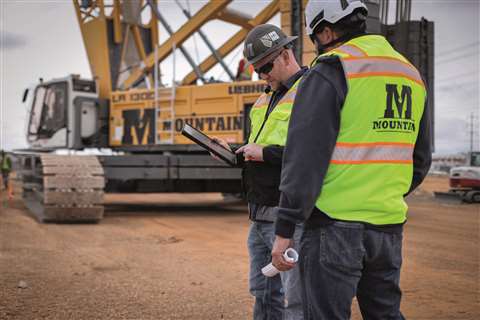How is lift planning integrated in safety and business?
18 May 2022
Hannah Sundermeyer speaks with engineering experts about the current state of lift planning.
Just as you wouldn’t take an exam without studying, a road trip without glancing at a map or bake a cake without checking out the recipe, the planning stage of any project is arguably the most crucial step.
 The demand for lift planning has steadily increased throughout the last decade.
The demand for lift planning has steadily increased throughout the last decade.
ACT queried three crane industry experts – Wes Dowd, director of operations and equipment, Davis Crane; Dan Durrett, director of engineering services, Maxim Crane; and Adam Parker, engineer, Mountain Crane Service – about the role of lift planning on today’s crane jobsite. Lift planning software has become an important technology that has transformed the way jobs are planned.
“I think back even 10 years ago we weren’t putting together near the number of lift plans that we’re putting together now,” said Durrett. “The industry as a whole has evolved.”
A crucial part of daily work for crane companies, and an enormous component of safe and successful projects, comprehensive lift planning is key.
 Wes Dowd, Director of Operations & Equipment, Davis Crane
Wes Dowd, Director of Operations & Equipment, Davis Crane
How is lift planning integrated into the structure of your business?
DOWD: We use lift planning to show the customer where the crane will be setup, and what area will be affected by the crane operation.
DURRETT: We perform initial lift plans for our customers on the sales side of things. So, they can use those to help plan the project or get an idea of the initial sizing of the crane that would be needed. Then once it kind of gets beyond their capabilities, they would pass it on to the engineering group, which is where we would take over. We would then put together a much more detailed, comprehensive lift plan.
PARKER: Growing demand for safety and planning has increased, therefore, the need/requirement for lift planning has increased. It is important to meet the need to stay in business.
Do you use it to bid jobs?
DOWD: We typically do not send a lift plan with a quote unless it is requested with it.
DURRETT: Our sales staff has access to 3D Lift Plan, which is one of the primary planning software packages that we use. A lot of times our sales staff is taking care of some of the more basic lift plans on their own. And then if there’s some other kind of reason that they might get the engineering group involved, we can jump in and either continue to use that software package or branch out and use some other options that we have to help solve whatever logistical or type of issues they might have with the site and the lift they’re performing.
PARKER: It really depends on the complexity and total dollar amount involved with the job.
Do you make a lift plan for every job you perform or just some jobs?
DOWD: We do not create a lift plan for every job, mainly only when requested, or if we feel there is a need to do so for the location we are at.
DURRETT: The first interface is really the sales staff. But I would say probably most of the projects that we do have some type of documented lift plan, at least a very basic lift plan that has been put together.
PARKER: Again, the complexity of the job dictates if drawings or lift planning is required.
 Dan Durrett Director of Engineering Services, Maxim Crane
Dan Durrett Director of Engineering Services, Maxim Crane
Which jobs do you generally use a lift plan for? How do you decide?
DOWD: All General Contractor sites, critical lifts, two crane picks and always when requested.
DURRETT: We see it a lot in industrial facilities, like refineries and things like that. We’re lifting up a 100,000-pound tank or a vessel, or we’re taking an old one out and replacing it. That’s probably most of the engineered lift plans that we work on is that kind of facility. We also do HVAC lifts on some high-rise buildings when working in a downtown environment where you have some real tight restrictions.
PARKER: Typically, refineries and plants require lift planning documentation. If the company we are working for has their own policies and procedures that require it, we provide it.
What lift planning software do you routinely use?
DOWD: 3D Lift Planner
DURRETT: 3D Lift Planner is one of our bread-and-butter tools. We use LICCON from Liebher, Crane Planner 2.0, which is another Liebherr product, CRANIMAX, CRANEbee. And we also use AutoCAD for some of the engineered type lift plans that we do, which are much more precise and more detailed.
PARKER: Proprietary software.
What are the features in lift planning software that are important to you?
DOWD: The ability to import jobsite prints and Google Earth images to show the exact setup location, the crane capacity and percentage of chart being used.
DURRETT: I think from our perspective, being a relatively large company, is just the database of cranes that are available. Our fleet is extensive and even crosses different lines and types of cranes from tower cranes to crawlers, to ATs and RTs, you name it. I think just the database of cranes is probably at the top of my list, and then functionality.
PARKER: The ability to use exact scaled dimensional layouts.
How do you get your people trained to use lift planning software?
DOWD: We have our onsite planner train them and use the online tutorials.
DURRETT: We use a combination of an internal and external training depending on what tool we’re actually talking about.
PARKER: Our lift planners mostly have on-the-job training.
 Adam Parker Engineer, Mountain Crane Service
Adam Parker Engineer, Mountain Crane Service
How do you structure the responsibility of lift planning in your company?
DOWD: Lift planning is crucial to us, and we have a sole person that is dedicated to lift plans only, and several others are trained in the event that he is out or extremely busy.
DURRETT: We kind of have it broken down into a series of different levels and it goes from level one to level four. The level one is your introductory lift plan, which our sales staff can use to basically size the crane or do a quick one-page presentation to the customer that just summarizes the primary information for the lift. This could be the type of crane, capacity, how it’s configured, percent of the chart, all those kinds of details. And then we go up to a level four lift plan and the level of effort, time and expense that goes into level two, three and four increases as you move up the line. The level four, one of our professional engineers signs and seals the document.
PARKER: We have an engineering lead that manages the lift plan request forms and ensures that they are finished and delivered in a timely fashion.
STAY CONNECTED


Receive the information you need when you need it through our world-leading magazines, newsletters and daily briefings.




